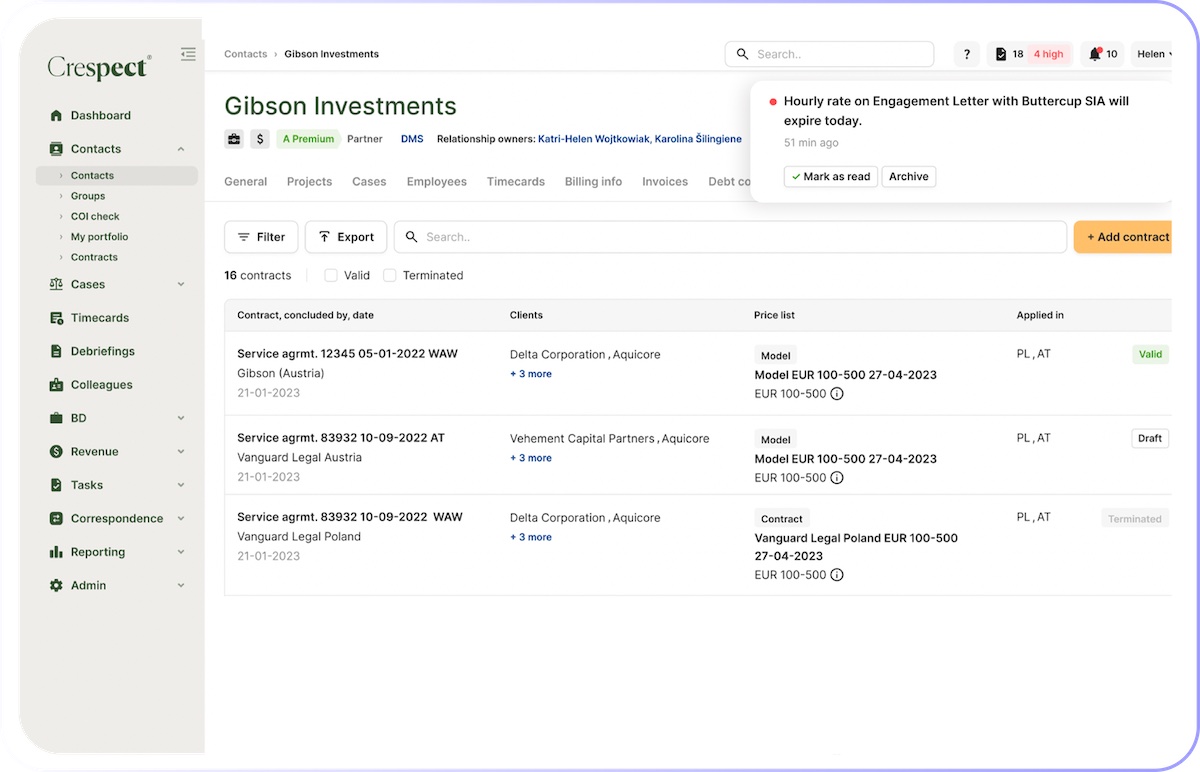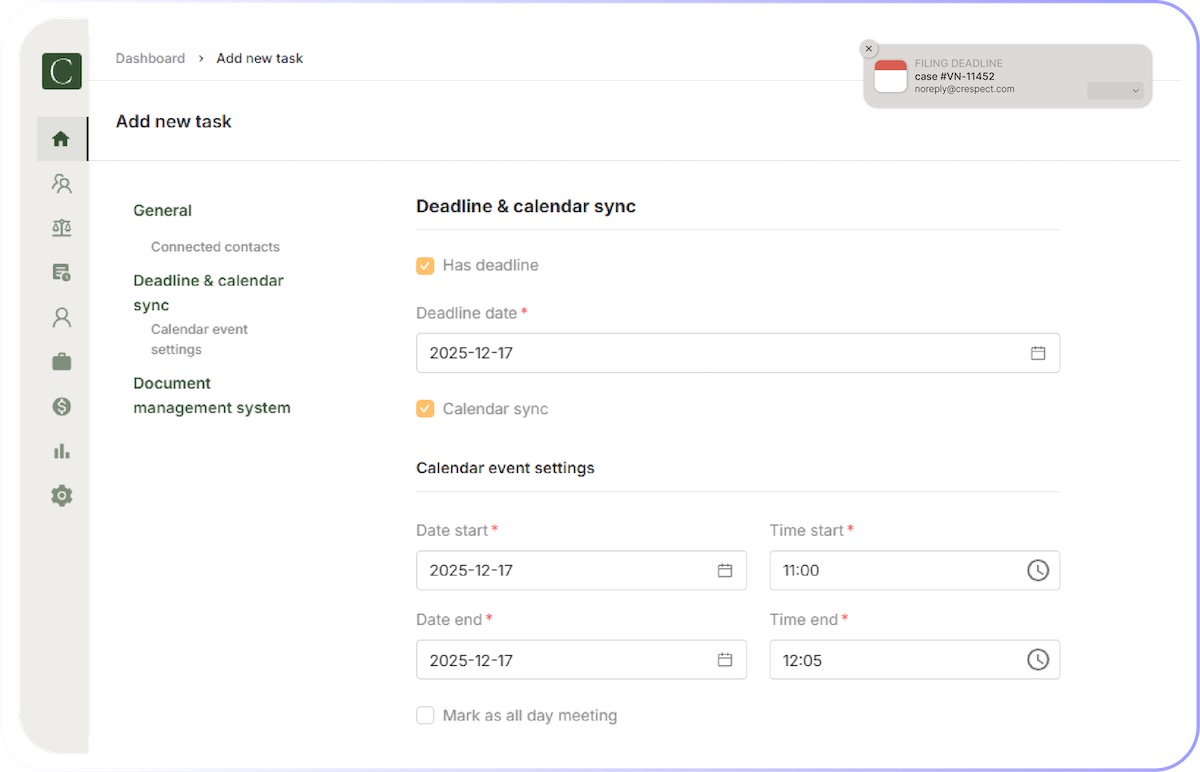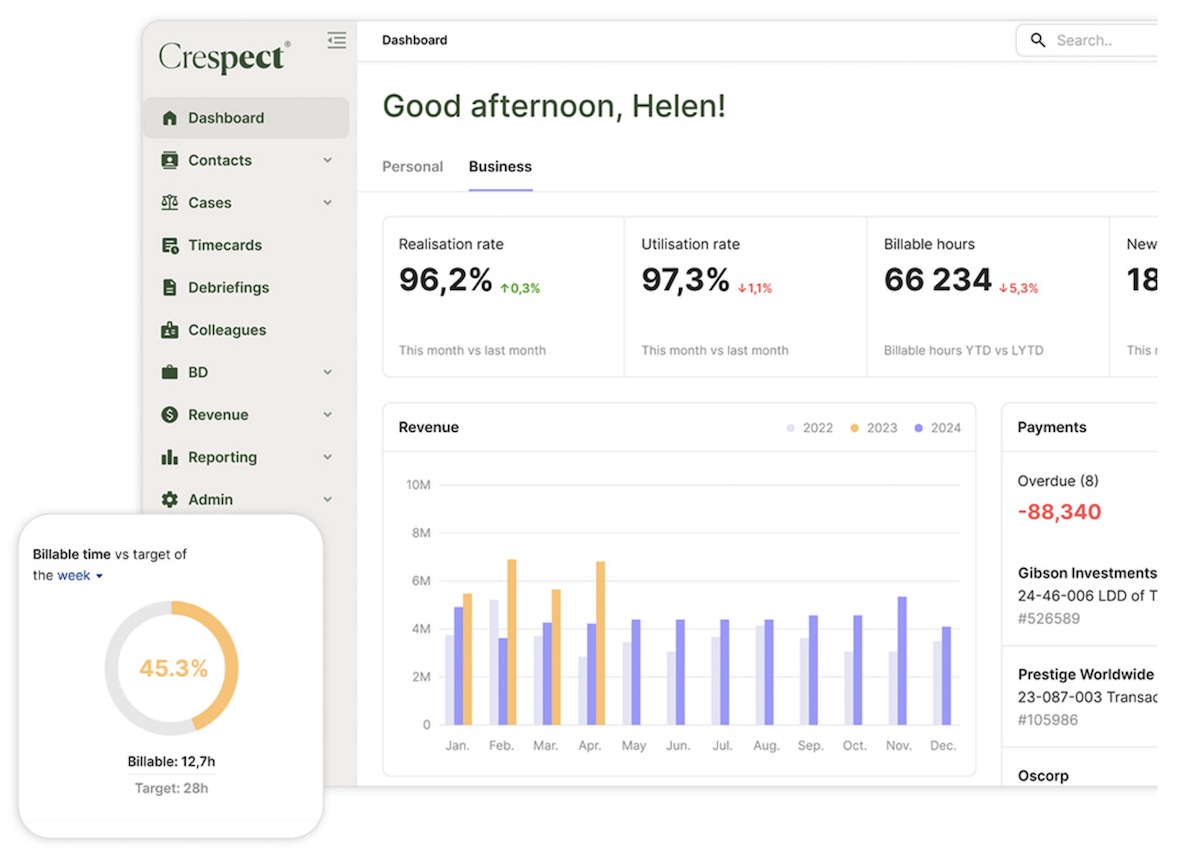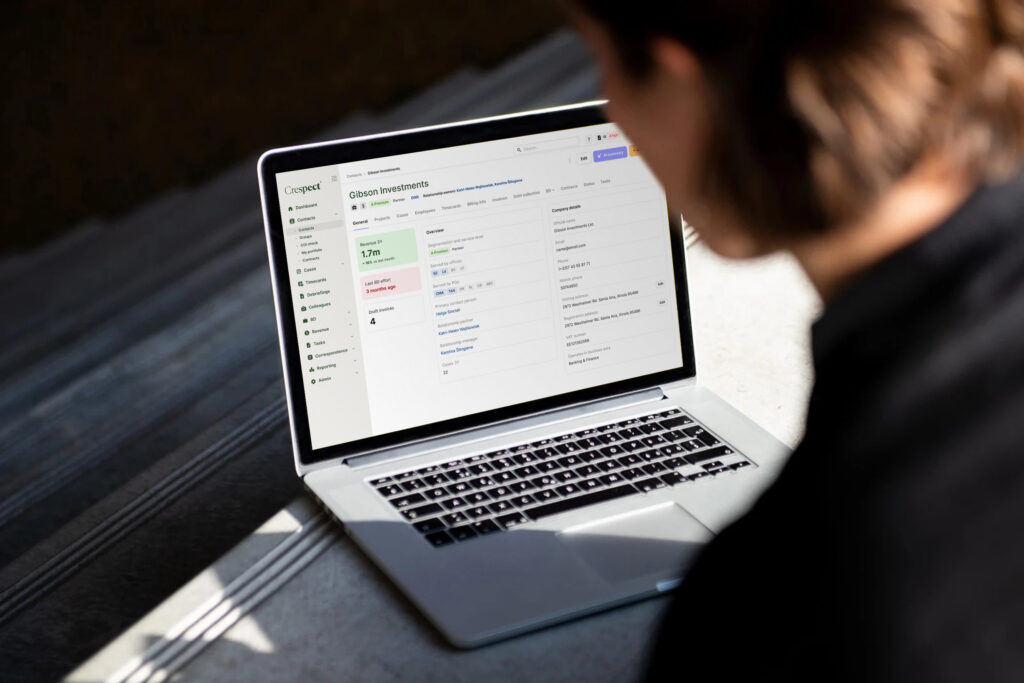Legal Practice Management – Ultimate 2025 Guide
Managing a modern law firm in 2025 requires more than spreadsheets and inboxes. Legal practice management software has evolved into a robust digital ecosystem that enables law firms to increase productivity, ensure compliance, boost client satisfaction, and streamline billing – all while maintaining airtight data security.
In this comprehensive guide from Crespect, we explore the 21 must-have features that your firm should expect from any leading legal practice management platform in 2025. Whether you’re evaluating your current tools or looking for a complete solution, this checklist will help you choose software that matches the complex needs of today’s legal professionals.
1. Case & Matter Management
Legal professionals juggle complex, multi-party cases. Disorganised case management leads to delays, errors, and frustrated clients.
Modern legal software, like the system we built at Crespect, centralises everything: engagement letter automation, pricing arrangements, opponents, third parties, budgets, multi-currency support, case notes, deadlines, assignments and tasks, access controls and quick access to case documents via DMS integration. Imagine finding every detail of a case within seconds.
“Us litigators still have a lot of paper files for cases, even though it’s the digital era… At least digital case management with quick access gives me freedom to handle my work without the classy suitcase until next court hearings.” — Litigation Partner, Tallinn
Easy to use Case management is essential in any modern LPM Software

2. Client & Contact Management with Grouping
Managing legal relationships goes beyond basic contact lists. Firms need CRM-style approach tailored to legal practice.
You should be able to group contacts by client importance, service level, easily identify is it a legal or a private entity, track referral sources, and even visualise who referred whom. This is key for both compliance and business development.
Did you know? Grouping clients can also help detect connected parties and potential conflicts of interest early.

3. Task Management & Workflow Automation
Deadlines matter. Errors cost money and reputation.
With a legal workflow system, you can predefine steps for each matter type – from a simple real estate purchase to a complex M&A deal. Delegate tasks, set reminders for yourself or colleagues – whether it’s a business development follow-up or a filing deadline – and stay in sync with everything on your desk.
Features like automatic reminders, task priority levels, notifications, and calendar integration ensure everyone knows what’s next.
4. Service Agreement Management & Status Tracking
Drafting, editing, approving, and tracking the status of service agreements with customers are central to law firm operations. Losing track of a contract’s status can be costly – providing services under an unsigned or terminated agreement can significantly weaken your profitability.
An ideal platform provides engagement letter automation, version control, automated reminders about contract validity, status of signing or termination keeps everyone informed. If a law firm fails to track the validity of its signed engagement letters properly, it risks costly lapses and potential compliance violations. These oversights can damage the firm’s reputation and undermine client trust.

5. Time and Expense Tracking with Stopwatch Functionality
Time is money – yet many lawyers lose revenue due to delayed time entry.
Simplicity and user intuitiveness are key to capturing all time spent, including non-billable activities like CRM updates or internal work. Smart legal platforms offer one-click timers, expense tagging, and multi-device sync. Some even integrate with various time-tracking tools to accommodate different work habits.
“Switching to automated time tracking increased our billed hours by 12% without working longer.” – Partner, Vilnius
6. Automated & Flexible Billing
Clients increasingly demand flexible, transparent billing – and law firms are under pressure to deliver it efficiently, without letting admin work eat into profitability.
Modern legal tech supports flat fees, capped fees, hourly rates, retainers, and milestone-based billing. Automated, paperless invoicing with a built-in review workflow helps firms quickly move from draft to sent invoice, without endless corrections or switching between systems and email. Support for multiple templates and customizable layouts for invoices and specification sheets (also known as breakdowns) ensures firms can meet client expectations and internal formatting preferences. Real-time chat for coordination, the ability to amend descriptions, update payers, process write-offs, or reassign timecards, all make billing smoother. Direct integration with accounting systems further reduces overhead, cuts down WIP, and helps firms ensure steady, predictable cash flow.
7. Multi-language and Multi-currency Support
With cross-border clients, flexibility is essential.
Your legal software should support:
- Client-specific languages, flexibility to use different languages for different cases
- Regional tax formats, including VAT rate adjustments and VAT applicability
- Multi-currency handling, including currency conversion and the flexibility to switch currencies when invoicing or recording expenses
Crespect goes further by integrating with the European Central Bank to provide live currency exchange rates, ensuring your conversions are always up to date. If preferred, connections with national banks can also be established to meet local requirements and preferences.
These features are standard in global-ready platforms like Crespect, helping firms operate seamlessly across jurisdictions without administrative friction.
8. Compliance and Conflict of Interest (COI) Management
Missing a conflict of interest can lead to serious legal consequences, lost clients, and lasting damage to your firm’s reputation. That’s why thorough conflict checks aren’t optional – they’re a critical part of risk management.
Conflict check tools scan the contact database to flag potential overlaps. Integrated directly into the intake process, it helps you catch risks early, not just after a client is onboarded. Crespect granular approach analyses keywords from CRM interactions, even with leads, surfacing potential conflicts before they become problems. Maybe they’re not a client yet, and maybe there’s no formal engagement, but the risk is still real. Need a second opinion? Send a quick link to a colleague in one click – no printouts, no delays, no switching systems.
9. Confidential Client & Case Management
Some matters must remain strictly confidential.
With robust rules and permissions management, your legal practice management system should offer full data transparency while allowing you to finely tune and limit access based on seniority, role, department, or any other relevant parameter. This ensures sensitive information is visible only to those authorised to see it, maintaining client confidentiality and compliance.
At Crespect, we support “confidential walls” (also known as “ethical walls”), which restrict case visibility exclusively to designated individuals. All activity within these cases is fully logged, providing an audit trail to ensure accountability and uphold the highest standards of privacy and ethical compliance.
10. Integrated Calendars & Deadline Alerts
Missing a deadline can cost more than just a case – it can damage a firm’s reputation, increase malpractice exposure, and even trigger claims under professional liability insurance.
A reliable legal practice management system should do more than track dates. Integrated calendar sync ensures critical deadlines are automatically reflected across platforms, while smart alerts and reminders help avoid costly oversights. Systems like Crespect support full calendar integration, email push notifications, and customizable marking of availability. This ensures the right people stay informed and accountable, without compromising on control or confidentiality.

11. Business Opportunity Recommendations
Using AI and business intelligence, modern legal practice management systems can identify opportunities, detect patterns, and provide valuable insights into industry trends and high-interest topics.
Platforms like Crespect leverage built-in analytics to surface cross-selling opportunities or alert you when key clients may need attention, helping you stay proactive rather than reactive. These tools also help you better understand growing client demands in specific areas and suggest relevant legal services they may benefit from – enabling you to build stronger, more loyal relationships.
12. Referral and Relationship Management
Law firm growth often relies on referrals and strong ties across international borders.
With Crespect, you can track not only who referred a client, but also the strength and value of that relationship. Monitor both inbound and outbound referrals – and go beyond just names. See how many cases and how much revenue each referral generates, giving you hard data to back strategic decisions.
You can also trace where each client or case originated – whether it came through a lawyer’s business development efforts, a successful marketing campaign, a client recommendation, or a foreign law firm. With this insight, you’ll know exactly what’s working and where to invest further.
Next time you’re on a roadshow or attending an international conference, you’ll have the data to show your commitment – and the results – to partners across jurisdictions.
“I hate small talk during international meet-ups. With data gathered on Crespect I can thank my partners for the work received and show how much work we sent their way. It’s not just good faith, it’s a data-backed relationship.”
— Senior partner, Tallinn
13. Transaction Experience and Credentials
Your past matters and deals are your strongest pitch. Once you have that nicely written description, don’t lose it ever again. Connect it with the client, case and also the referee who could commend your contribution.
Crespect lets you tag, export and recycle credentials by industry, jurisdiction, or case type – perfect for RFPs, legal directories, and marketing.
14. Non-billable Time Tracking (Internal Clients and Tasks)
Training, research, internal meetings, marketing efforts, business development, and internal legal work – these activities may not be billable, but they represent real time and strategic investment.
With Crespect, you can open non-billable cases to track this work just as precisely as client matters. Capturing these timecards helps firms gain a full picture of staff productivity, justify internal resource allocation, and evaluate the true cost and impact of non-client-related activities.
Understanding how much time is spent on internal tasks isn’t just good reporting – it’s essential for smart planning and long-term growth.
15. Reporting & Financial Dashboards
Want to know your most profitable client type? Or apot underutilised resources?
You need visual dashboards with customizable reports: revenue, billed hours, WIP, top-performing cases and clients, and practice area performance. You also might want to track realisation rates to see how much of the worked time actually turns into revenue, including visibility into non-billable hours such as internal work, training, or business development. This gives a complete picture of how time is spent – and how it translates into firm profitability.
With Crespect, lawyers can monitor their own performance and targets directly within the platform, reducing the need for constant supervision and freeing up team leads from micromanagement.

16. Custom Roles & Permissions
Law firms must strike a careful balance between transparency and privacy.
With granular permissions, you can define and enforce your own internal data accessibility policy – tailored to your firm’s structure and needs. Whether by seniority, department, or case type, you stay in full control.
You can:
- Allow junior staff access to select data only
- Restrict financials to partners
- Log and audit every access attempt
- Ensure the security of confidential clients and cases
Your firm’s data stays both secure and accessible – exactly how you decide it should be.
17. Custom Fields & Configurability
Every law firm operates differently – your software should adapt, not the other way around.
Add custom fields to clients, cases, or invoices, and more, tailor the platform to your exact workflows. Integrate seamlessly via REST API and enjoy smooth data flow across your existing tools and systems.
Crespect has integrations with popular business software and can deliver API endpoints for your needs. Whether you’re building a tightly connected tech ecosystem or just need a few strategic integrations, Crespect gives you the control and configurability to scale efficiently.
18. Data Exporting & Portability
Firms own their data. Period.
A modern legal platform must make it easy to access, export, and migrate your data whenever needed, without vendor lock-in. With Crespect, you benefit from advanced filtering, bulk export capabilities to Excel, PDF, and open formats, and compliance with GDPR data portability requirements.
Whether you’re preparing internal reports, or responding to audit requests, Crespect ensures that your data remains accessible and usable at all times, you can extract exactly what you need, whenever you need it – empowering your firm to stay flexible, compliant, and in control.
19. Mobile Access & Cross-Device Compatibility
Modern legal work isn’t confined to the office – and your platform shouldn’t be either.
Crespect and similar platforms offer mobile access, screen adjustability, and cross-device compatibility so lawyers can work seamlessly across laptops, tablets, and phones, with full feature parity. Whether you’re reviewing documents on a train, tracking time from a meeting, or checking a deadline after hours, the interface adapts to your screen and workflow.
With support for Single Sign-On (SSO), Crespect integrates with your company’s identity provider for simplified, secure access control. This means users get a smoother login experience, while IT teams maintain centralised authentication, monitoring, and policy enforcement.
Mobility, usability, and security – all without compromise.
20. Security, Backup, and GDPR Compliance
Your clients’ secrets are sacred.
Expect enterprise-grade security: end-to-end encryption, daily backups, MFA, and full GDPR alignment, seek for certificates and proof of third-party penetration testing based on internationally recognised OWASP, OSSTM and NIST standards.
21. Training & Support Availability
Buying software is just the start. Adoption is everything.
Look for a provider that understands the unique structure and pressures of legal practice. Choose a partner with real-world law firm experience, not a generic IT vendor.
Crespect was born from the operations of the international law firm Sorainen. As a spin-off company, it has translated ISO-certified best practices of legal management into a powerful, purpose-built platform. This means you’re not just getting software – you’re getting tools designed by people who truly understand how law firms work.
Choose a platform with onboarding support, super-user training, accessible knowledge center, FAQ, documentation, multilingual and readily available help desk.
Conclusion: Choose the Right Legal Practice Management Software for 2025
The legal world has changed—and so have client expectations. Whether you’re a boutique firm or a multi-national practice, your software should empower your team, protect your data and drive business forward.
Crespect is designed from the ground up to meet all of these modern requirements. It’s flexible, secure and built with legal professionals in mind.
Ready to future-proof your firm? Explore Crespect’s platform or request a personalized demo today.








